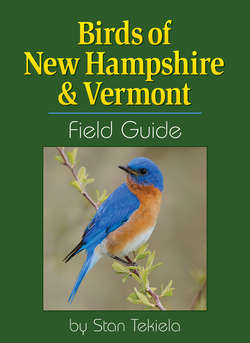Читать книгу Birds of New Hampshire & Vermont Field Guide - Stan Tekiela - Страница 23
На сайте Литреса книга снята с продажи.
Оглавлениеwinter
breeding
European Starling
Sturnus vulgaris
YEAR-ROUND
| Size: | 7½" (19 cm) |
| Male: | Gray-to-black bird with white speckles in fall and winter. Shiny purple black during spring and summer. Long, pointed yellow bill in spring turns gray in fall. Short tail. |
| Female: | same as male |
| Juvenile: | similar to adult, gray brown in color with a streaked chest |
| Nest: | cavity; male and female line cavity; 2 broods per year |
| Eggs: | 4-6; bluish with brown markings |
| Incubation: | 12-14 days; female and male incubate |
| Fledging: | 18-20 days; female and male feed young |
| Migration: | non-migrator to partial; some will move to southern states |
| Food: | insects, seeds, fruit; will come to seed and suet feeders |
| Compare: | Similar to Common Grackle, but lacks its long tail. The male Brown-headed Cowbird is the same size, but it has a brown head and longer tail. |
Stan’s Notes: A great songster, this bird can mimic other birds and sounds. Often displaces woodpeckers, chickadees and other cavity-nesting birds. Can be very aggressive and destroy eggs or young of other birds. Jaws are designed to be the most powerful when opening; the birds can pry crevices apart to locate hidden insects. Bill changes color with the seasons: yellow in spring, gray in autumn. Gathers in the hundreds in autumn. Not a native bird, it was introduced to New York City in 1890-91 from Europe.
